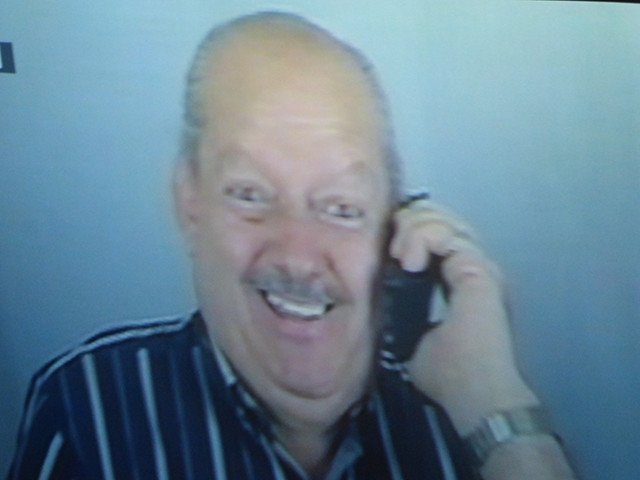
A still from Raul Ortega Ayala’s found screentest reel. I can totally see this guy playing someone’s comic relief tío on a telenovela.
Public Art Projects presents: SET
Pop-up in Mexico, DF, Mexico
http://publicartprojects.org/
Artists: Aldo Chaparro, Juan Pablo Vidal, Karla Leyva, Marco Esparza, Raul Ortega Ayala, Sofía Táboas
Last weekend I attended a pop-up group show from Public Art Projects on a quiet industrial block of Juarez just south of the Material Art Fair on its last day. The group launched an exhibition that mischievously embraced site-specificity in a venue that is by nature the most mutable of non-places: a television studio.
Arriving at the space, my immediate impression was of a loft in the middle stages of being gentrified—alternating between IKEA-esque model rooms and raw spaces reminiscent of an autobody shop. A convincing living room, complete with knick-knacks, offered a television playing an unnerving loop of people cycling through painfully fake facial expressions and greetings. Instead of family photos, a frame held an anthropological/physiognomical image of a scientist measuring a man’s forehead. The photo was found by the artist Raul Ortega Ayala (who also created the infamous “Babel Fat Tower” at Zona MACO) and paired with excerpts from the studio’s archive of screen tests. The canned emotions and gestures on the screen are oddly comic and uncanny documents of years worth of auditions for TV commercials and telenovelas—here far removed from Warhol’s forays into the medium by their pairing of “average-looking” people with the racially charged pseudoscientific photograph.
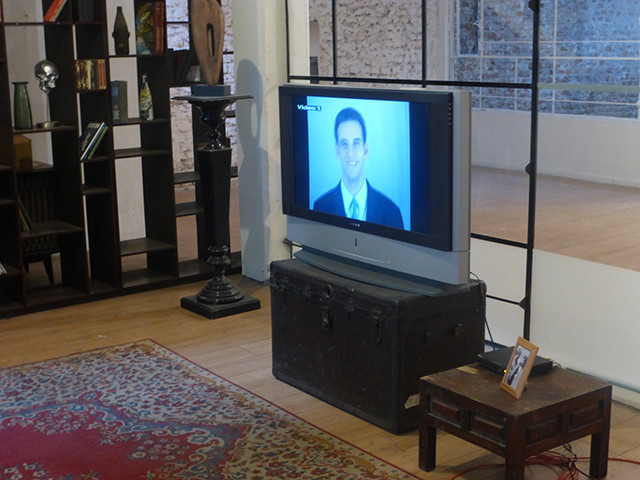
Detail from Raul Ortega Ayala’s installation.
As one moved away from Ayala’s piece, a camera captured the viewer from behind a slice of meat and other ephemera. That feed was projected into an adjacent, empty set. The meat/camera setup was the work of Marco Esparza, who positioned the camera behind a clothesline strung with materials associated with his native Chihuahua: insulation foam, cattle, and faux-snakeskin used to make boots or belts (I was told Chihuahua is stereotyped as a “cowboy” town with cold winters). The “curtain” of objects served as a backdrop to psychosomatically represent a place—a unique take on the idea of a film set, made even stranger by its foregrounding in the camera’s shot. The dangling materials almost read like a regional costume to be assumed by the “actors” passing by.
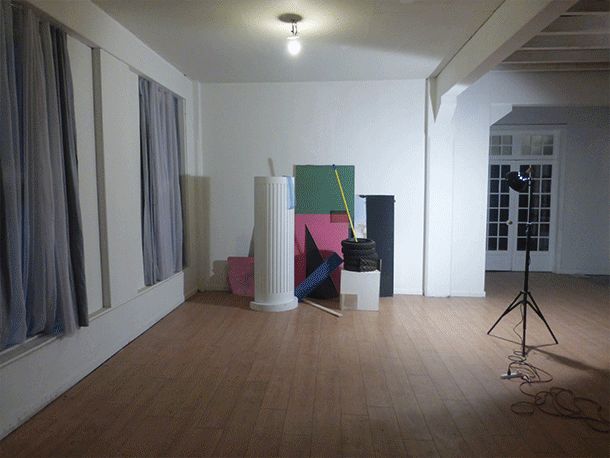
The relationship between reality, a camera’s image framing, and set decoration is addressed less opaquely in Karla Leyva’s work, which occupies two perpendicular alcoves. In one, an assortment of props from the studio’s storage are arranged somewhat unceremoniously. In the other, a photograph of the still life reads as a far more precious object than the kitsch and scrap material it indexes. It’s an effective—if not obvious—demonstration of representations transformative qualities.
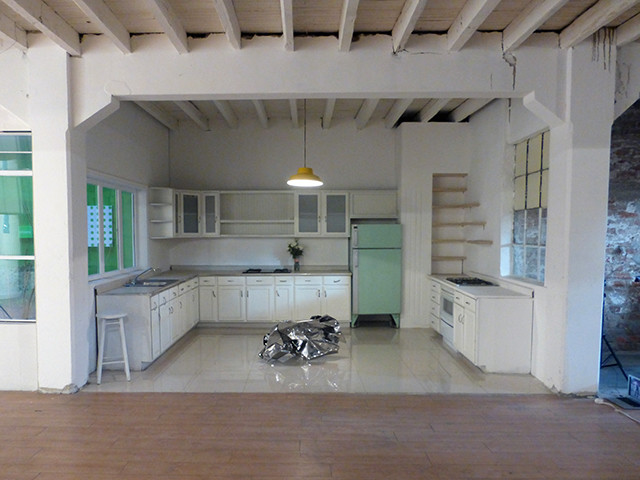
Aldo Chaparro, installation view.
The most visually striking work in the show, from Aldo Chaparro, was a crumpled sheet of stainless steel positioned to reflect the studio lights around a model kitchen like a postapocalyptic disco ball. It’s evocative of an oversized piece of discarded aluminum foil, or perhaps an imploded appliance. The piece was actually an artifact from Public Art Projects’ first curatorial project, in which artwork was installed in a derelict building slated for demolition. The entire show was reduced to rubble—or perhaps treasures for a future archeologist—when the building was levelled. This sheet of now-crushed metal was excavated from the site for this exhibition. Its provenance within the cycles of the real estate/construction industry makes it the perfect piece to subvert the television-idealized domestic space.
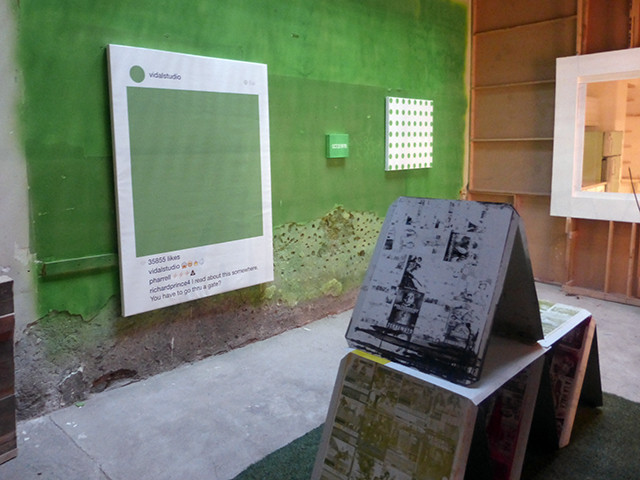
Juan Pablo Vidal, installation view.
In the “outside” of the “kitchen”, Juan Pablo Vidal created a green screen room with chromakey paint, nodding to both Mexico City’s status as a media production capital and reputation for counterfeit goods. Any fantasy could be projected into the space. The installation seems to suggest that as D.F. adds “art market hotspot” to its repertoire of roles, the city’s bootleg economy might adapt to provide forgeries as well. Here, some of the art world’s hottest selling brands are copied in the room’s signature green paint.
There’s a knock-off Richard Prince Instagram-on-canvas print, implying that Prince had ripped-off Vidal’s post of a blank green square. It’s complete with fake comments from Prince himself (cryptically: “I read about this somewhere. You have to go thru a gate?”) and Pharrell, who replied with a string of lightening bolt and poop emojis. Next to a monochrome faux Damien Hirst “Spot Painting”, a counterfeit On Kawara has a subtle defect—the artist pointed out it’s the wrong size for the date depicted. These are the art world equivalent of knockoff Fendi purses with Gucci logos one might encounter in Mexico’s Lagunilla market.
The only piece not rendered in chromakey green is a fake Richard Serra “House of Cards”. The steel panels here are the printing plates used by bootleggers to mass-produce the covers for illegal DVD copies. Apparently a garbage man who knows of Vidal’s penchant for unusual materials fished them from a dumpster and saved them for the artist. They’re great—everything from “Cincuenta Sombras de Grey” to “Mad Max: Furia del Camino” is depicted in a grid of blurry CMYK registration prints. It’s a totem to the precariousness of intellectual property, and the most fitting Momento Mori for a site of film production.
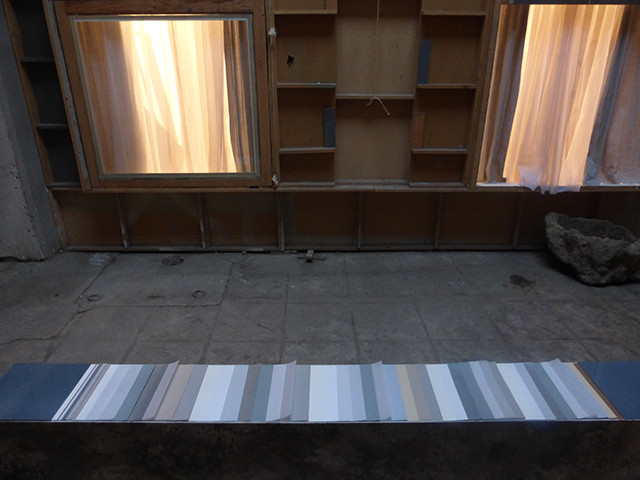
Sofía Táboas, installation view.
In the other “outdoor” zone, Sofía Táboas installed a piece that I never would’ve found without a tour. Behind an existing false wall, the artist exhaustively indexed the colors of every piece of “behind the scenes” infrastructure as they appear under the vestigial space’s rare natural lighting. These colors were reproduced exactly on sheets of paper arranged like a designer’s color palette—as if a set decorator had diligently noted the off-camera spaces for the illogical sake of absolute consistency from one take to the next. This piece remains memorable for it’s total ephemerality and utter lack of salability—after visiting a commercial art fair, it was comforting to be reminded that sometimes artists pour an irrational amount of labor into a poetic gesture that can’t be commodified. Photography doesn’t even do justice to the inexplicable beauty of the papers vibrational correspondence to their surroundings. The piece only makes sense as a monument to its bizarre context: an un-place, under a skylight in a forgotten corner behind the windows of a fake living room.


Comments on this entry are closed.